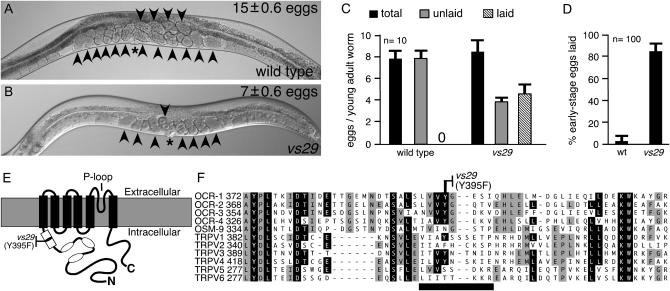Figure 1.—
A missense mutation in the TRPV subunit OCR-2 causes eggs to be laid before the uterus is full. (A and B) vs29 animals accumulate fewer eggs than do wild-type animals. Representative wild-type (A) and vs29 (B) animals are shown. The average number of eggs accumulated by each strain, the vulva (asterisk), and eggs (arrowheads) are indicated. (C) vs29 animals begin to lay eggs earlier than do wild-type animals. Animals isolated at the late L4 stage were aged 11.5 hr. The total eggs produced during this time, the number laid, and the number retained in the uterus (unlaid) were counted. Averages for 10 animals/genotype are shown. Error bars indicate a 95% confidence interval of the mean. A 0 on the x-axis indicates that no laid eggs were seen for the wild type. (D) vs29 animals lay premature eggs. The developmental stages of freshly laid eggs (100/genotype) were determined. The percentage of eggs not yet developed beyond the eight-cell stage (early stage eggs) is indicated. Error bars indicate 95% confidence intervals. (E) TRPV channel subunit schematic. Functional channels are tetramers of such subunits. Ankyrin repeats (ovals), conserved region containing the vs29 mutation (open rectangle), transmembrane domains (solid rectangles), and pore (P)-loop are indicated. (F) vs29 mutation is in a region conserved in C. elegans and human TRPVs. Multiple sequence alignment of this region from C. elegans TRPV subunits (OCR-1–OCR-4 and OSM-9) and from human TRPV1–TRPV6. Amino acid residues identical in more than six or in five to six subunits are solid or shaded, respectively. The sequence change in vs29 is indicated and lies within a region (horizontal solid line) that is missing in the murine dominant-negative subunit TRPV1b (Wang et al. 2004).

